Browse in the Library:
Or browse in the categories menus & download the Library Catalog PDF:
DREAM – JOHN CAGE with sheet music download.

John Cage
(Los Angeles, 1912 – New York, 1992) American composer. Also a poet and essayist, he is placed within the North American avant-garde current of the second half of the 20th century, influential both in contemporary experimental trends in the United States and in Latin America.
The son of an engineer and inventor of electronic devices and submarines, he entered the University of Pomona (California), and later studied architecture and piano in Europe. John Cage very early developed a calm but tenacious desire for experimentation applied, in particular, to music, but in a broader field of exploration of language. His learning experience with Arnold Schönberg was essential, which immediately turned him into a radical composer, inventor of music experienced as an ‘aggregation of sounds’ and, therefore, also of ‘silences’, defined as ‘inaudible sounds’.
In his musical production, Cage goes beyond any pre-established category, including the twelve-tone. After having crossed all the harmonic barriers, his unorthodox use of traditional instruments led him to the discovery of unpublished sonorities. In this area is the idea of the ‘prepared piano’ (1938), which consists of creating unexpected sonorities by placing desecration objects such as nuts and bolts between the strings of a traditional piano. The adoption of silence as an integral part of the musical score -his 4’33” (1952) is famous in this regard, which allows ambient sounds to penetrate its 4 minutes and 33 seconds of silence- already consecrated Cage at the forefront of music.
But other relevant aspects of his poetics earned him a prominent place in the world of contemporary philosophy: for example, the adoption of ‘alea’, or composition through casual operations (‘alea operations’). With the use of ‘alea’, and denying the author any demiurgic quality, Cage definitively consecrates the end of all ideology and ratifies the affirmation of postmodern aesthetics. HPSCHD, from 1968, is situated in this sense, a work for harpsichord and computer programmed according to the Chinese I-Ching ‘book of mutations’.
Throughout his long career, Cage influenced the work and poetry of innumerable artists and intellectuals, becoming himself a main reference for the American avant-garde and, in general, for contemporary aesthetics. His collaboration with Merce Cunningham, dating back to 1942, and theoretical work on sound and movement, collaboration with visual artists such as R. Rauschenberg and J. Johns, experience (1948-1950) with the Black Mountain poets ( Charles Olson, Denise Levertov, Robert Creeley), the intense friendship with Marcel Duchamp, his chess teacher, and the Darmstadt seminars (1958), constitute important pieces of the Cage-mosaic.
The philosophical framework on which these are amalgamated is the Zen doctrine, in which Cage deepened between 1945 and 1946 thanks to D. T. Suzuki and which he immediately adopted as a reassuring ideology to oppose it to the narcissism of Western culture. The attitude of silent ‘listening’ to nature -of which technology also becomes a part- constitutes the basic epistemological ground on which Cage builds his works; from the first percussion scores of the 1930s to Branches (1976), for amplified plant materials, and to the Montestella d’Ivrea sound project: The Park Amplified Project (1979).
And as if he were an epistemologist committed to the global study of language, Cage also records the reality that surrounds him, transforming it not only into musical scores, but into books of essays and anecdotes such as Silence (1962) and A Year from Monday ( 1967). Or in newspapers, like Diary: How to improve the world (1965). Or transforming it into ‘verbal scores’, that is, rewritings (by means of ‘chance operations’), of the works of the transcendentalist Henry David Thoreau -the man of the woods-, or of James Joyce’s Finnegan’s Wake, or simply of mushroom names as Mushroom et Variationes (1984). Other times, transforming this reality into etchings and incisions, extracted as always in a ‘casual’ way from the sketches of Henry David Thoreau.
These multiple aspects of Cage’s poetics always influence each other, to be part of the incessant search of this refined sonority engineer. It is also worth mentioning his works Southern Studies and Sonatas and studies for prepared piano.
